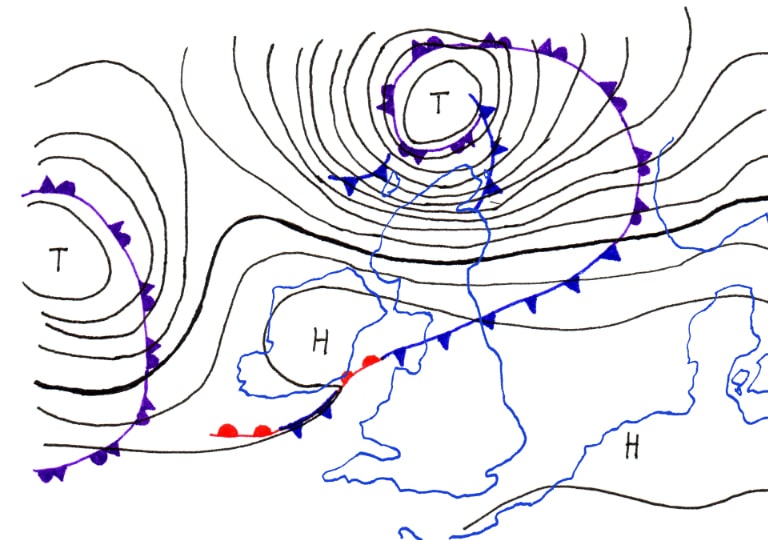Welcome to the Arta Mani Gostar WebSite.

Do not confuse it with climatology.
Meteorology is a branch of atmospheric science that includes the nature and physics of the atmosphere with the aim of focusing on weather forecasting. The study of meteorology dates back to thousands of years ago, but the main processes in this field were not carried out until the 18th century. In the 19th century, relatively few processes were carried out after air-monitoring networks were set up in outdoor neighborhoods. The main efforts in forecasting the weather depended on information and data. No work had been done before the laws of physics and, more importantly, the use of computers were stated. Using a computer to solve many equations for climate modeling. In the second half of the twentieth century, significant advances were made in weather forecasting. Meteorological phenomena are observable climatic events that are explained by meteorological science. Meteorological phenomena are explained and interpreted by changes in the Earth’s atmosphere: temperature, air pressure, water vapor, wind flow, and the relationship between these variables and how they change over time. Different spatial scales are used to describe and predict the climate of a local, regional and global. Meteorology, climatology, atmospheric physics and atmospheric chemistry are subfields of atmospheric sciences. Meteorology and hydrology together create a new field called meteorology. Interactions between the Earth’s atmosphere and the oceans are part of the oceanic atmosphere system. Meteorology is used in various fields such as the military, energy production, transportation, agriculture and construction. The word meteorology in English has Greek roots and means very high in the sky and the study of objects in the air.
Contents
1 lexical root
2 Overview
3 Differences between meteorology and climatology (meteorology)
4 History
4.1 Evolution and growth
4.2 Meteorology in Iran
5 Related Articles
6 sources
Lexical root
The Greeks used the word methyorologia, derived from the word “metiorus”, meaning suspended objects in air experiments, plus “logos”, which translates to sermon or lesson. However, today the study of the Earth’s atmosphere is so divided into specialized disciplines that the universal term meteorology, left over from the ancient Greeks, does not satisfy anyone. Hence, to study a part of the atmosphere where ionization and rupture are important and generally above an altitude of about 35 km, the term aeronautics (near the upper atmosphere) is used, while some, as a universal name, use science. (Or science) like the atmosphere. The fifth century Iranian scientist, Abu Hatem Ismail Asfzari Khorasani, for the first time in the world has collected atmospheric and meteorological phenomena in Persian in his book called Alavi Works.
quick look
The study and research of all aspects of the Earth’s atmosphere, which covers in detail from the Earth’s surface to the upper atmosphere, is now called the Atmospheric Sciences. The older term, meteorological, refers to the study of the lower levels of the atmosphere, which is constantly changing. From the beginning of creation, human beings have always been curious about the discovery of atmospheric phenomena due to their close contact with nature and objective observation of atmospheric phenomena. The first objective experience of atmospheric phenomena may have been the observation of lightning and forest fires, which later led to the discovery of fire. Also, the first human attempt to prepare food and agriculture was accompanied by air surveillance. Meteorology is a specialized branch of advanced physics that utilizes sophisticated mathematical tools and relies on all the sciences of physics. Meteorology deals primarily with the theory of electromagnetic radiation, thermodynamics, classical mechanics, fluid physics, physical chemistry, and boundary layer theory. If the underlying atmosphere is included, solar physics, spectroscopy, plasma physics, ionization, elementary particle physics, X-ray phenomena, cognition, cosmic ray physics, excitation phenomena, electrodynamics, magneto-hydrodynamics, radio emission, and other related processes Must be learned.
Meteorological and climatological differences (meteorology)
A meteorologist working in Oklahoma
Although the subject of meteorology and climatology is the atmosphere, each examines it with a different perspective:
Meteorology identifies and explains the weather and climatology.
Meteorology examines the weather in general for a moment; However, the meteorology of the prevailing weather type of a particular place over a long period of study and the climatic differences of places.
The goal of meteorology is the absolute and general knowledge of the atmosphere and its changes (air); However, in meteorology, it is tried to determine the effects of each region on human activities by knowing the climate of each region.
The meteorologist predicts the weather in the short term; However, the meteorologist predicts the emergence of a specific climate in a specific place and according to its impact on human life, based on the factors that create the climate.
The meteorologist’s identification and justification tools are physical and dynamic principles, laws, and models. But in addition to the principles of meteorology, the tools of meteorology are also the principles and concepts of geography
History
Edmund Holly first published documents in 1688 on atmospheric phenomena and maps of successive winds on the surface of the oceans for part of the earth’s surface. In this way, a step is taken to meet the maritime needs. The first thinker to codify and classify meteorological events and he should be rightly called the father of meteorological knowledge, Iranian scientist of the fifth century AH, Abu Hatem Asm